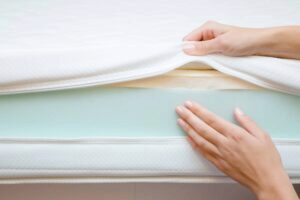Memory Foam vs. Innerspring Mattresses
Disclosure: By clicking on the product links in this article, Mattress Nerd may receive a commission fee at no cost to you, the reader. Read full disclosure statement.
Online or in-store, it seems like every mattress out there claims to give you the best night’s sleep. While that’s obviously too good to be true, some beds really are better for you than others. Depending on your body type, how much you sweat, and even your age, some beds will feel pretty close to perfect, and others might feel, well, flat out terrible.
However, before you lose too much sleep over choosing the right bed, we’re here to help. Instead of trying to keep track of everything while mattress shopping, just knowing a bed’s materials or type can tell you a lot about how it’ll feel.
So, today, we’re taking a closer look at the pros, cons, and differences between two super common mattress types: memory foam and innerspring mattresses (TLDR at the bottom if you’re in a hurry).
Nerd Lab Video Breakdown
Want to see the memory foam vs. innerspring bed comparison, instead of just reading about it? Join our editors Loren and Corey in the Nerd Lab as they run through the pros and cons of each mattress type:

What Is a Memory Foam Mattress?
If you’ve been mattress shopping before, or if you get bombarded with mattress ads a lot, you’re probably familiar with memory foam beds. But, if you’ve never lied down on one, just know that they conform around and take pressure off of your body, they feel soft and sinking, and they were invented by NASA (sorta).
However, it doesn’t take a rocket scientist to learn how an all-foam or memory foam mattress works. The top layer of a foam bed is the comfort layer: it’s the softest and has that signature memory foam feel. Some beds even include cooling gels within this top layer. Then, below that are the more firm layers of foam that add more support for your body and more durability to your memory foam bed.
Memory Foam and Polyfoam
The term “memory foam” is actually pretty broad, and it refers to any bed that’s made entirely of foam, whether that’s technically “pure” memory foam or its cousin polyurethane foam (polyfoam). The main difference between the two is that memory foam has that classic “slow” foamy feel, while polyfoam has more bounce—but it’s a little cheaper and less durable. That said, if you’re still on the fence about foams, our memory foam and mattress buyers’ guides go in more detail about each.
Pros
Now, let’s cover what makes memory foam beds great, other than being made by NASA:
Motion isolation: Memory foam beds have great motion isolation and allow for very little motion transfer. Essentially, motion transfer is when movement or weight on one side of a mattress can be felt throughout the bed. If you sleep with a partner, memory foam beds are ideal if you don’t like getting woken up by them tossing and turning.
The reason why memory foam beds do such a good job of muffling unwanted movement is because foam is super pressure-absorbent. Even if you jump on memory foam, you’ll just “sink” in place instead of bouncing back.
Pressure relief: Moving on, memory foam mattresses also do an outstanding job of relieving pressure. There’s simply nothing hard or rigid in memory foam that could create pressure points on your body. And, for sleepers who struggle with aches and pains, this relief definitely puts memory foam at the top of the list for mattress types.
Side support: Because of memory foam’s pressure relieving qualities, this kind of bed is also a great option for side sleepers. Of all the sleeper types, side sleepers usually need the softest kind of bed since they tend to experience pressure build-ups along their sides (especially in the shoulders and hips) when on firmer mattresses.
Cons
Memory foam has a lot of perks, but it’s definitely not for everyone. So, let’s cover some downsides to this foam and what kind of sleepers might want to stay away:
Temperature control: Memory foam mattresses sleep hot. If you do too, then they might not be your ideal bed type. In fact, memory foam actually works by absorbing your heat to mold itself closer to your body’s pressure points. Over the course of the night, this trapped heat will radiate back to you, which can be a dealbreaker if you overheat or sweat at night.
Unresponsive: If you’re a combination sleeper (meaning you change your sleeping position throughout the night), or if you sleep with a partner, memory foam might not be for you. The reason why is that foam is notoriously unresponsive—it’s like quicksand.
Off-gassing: Off-gassing is essentially the “new mattress smell” that comes after unboxing your new bed. And, this one might seem odd, but memory foam mattresses are smellier than other types of beds. Since polyfoam and memory foam are both synthetically made, they can be off-putting to shoppers who are especially sensitive to harsh, chemical odors that can linger for days.
What Is an Innerspring Bed?
Going back in time to the 1800’s, innerspring beds are the original mattresses. Chances are that you’ve laid on one at some point in your life, if you’re not on one right now. But, if you’re not sure, the term “innerspring mattress” simply refers to any kind of bed that has a support layer of coils or springs and has a soft comfort layer on top. However, if that comfort layer is extra comfy and thick, you might actually be on a hybrid mattress.
Innerspring and Hybrid Beds
To be more specific, a hybrid bed is a hybrid of the innerspring mattress and the foam mattress. They still have a support layer of coils, but their comfort layer is soft, sinking (like a foam bed), and over two inches deep. Anything less than that and it’s still just a regular innerspring bed.
If hybrid beds put you to sleep, but reading about them doesn’t, check out our full guide to hybrid mattresses.
Pros
Now, that we’ve gone over what innerspring (and hybrid) beds are made of, let’s cover who and what they’re best for:
Cooler: Innerspring beds keep your body lifted, they have thinner comfort layers, and they get more airflow through their coil support layer than other types of mattress. As a result, these mattresses feel cool and airy. If sleeping hot is your primary concern when shopping for a new mattress, an innerspring mattress is almost certainly your best bet.
Responsive: Also, if you’re a combination sleeper, or if you sleep with a partner, innerspring mattresses are super responsive and easy to move around on. Since this type of mattress has thinner comfort layers and firm, bouncy coils, you won’t feel yourself getting lost in your own bed.
Better for Back Sleepers: Next, if you usually sleep on your back, you’ll probably find that innerspring beds feel the most comfortable. Not only that, but stomach sleepers will say the same thing too. What’s going on here? Well, back sleepers need lower back support, and stomach sleepers need extra firmness to keep their hips up. Both types of sleepers benefit from a supportive mattress more than a soft one.
Cons
Innerspring beds are the OG bed, but that doesn’t mean they’re perfect. Here’s a few downsides to sleeping on an innerspring mattress:
Motion transfer: Not only do innerspring mattresses have a lot of coils, but they also have a lot of coils that are all connected to each other. The result is that innerspring mattresses tend to have pretty subpar motion isolation. So, if you’re sharing your next innerspring bed, you might be sharing every toss and turn too.
Fortunately, however, not all innerspring beds have this issue. Some of them have pocketed coils, which means that the bed’s springs are separated from each other. Essentially, this helps to stop pressure and motion from moving between coils and across the whole mattress.
If you want to check out some mattresses that have this feature, take a look at our best innerspring mattresses.
Pressure: The firmness and bounce of an innerspring bed appeals to a lot of different sleepers, but people with aches and pains may want to pass. Because innerspring mattresses keep you lifted and have thinner comfort layers, they also put pressure points on several areas of the body like the shoulders, hips, and back.
Cheaper: If you’re mattress shopping on a tight budget, this one might not even count as a con. However, there are a few downsides to cheaper innerspring beds. For example, these beds have wire coils instead of steel and traditional coils instead of pocketed.
Overall, the cheapest innerspring mattresses aren’t super durable, and, without a great warranty, you might find yourself mattress shopping again only a few years later.
Bed-to-Bed: Memory Foam vs. Innerspring
We’ve gone through what makes a memory foam or innerspring mattress, layer by layer; so let’s see how these mattress compare to each other:

Feel
Like a blind date, you can’t really check your mattress’s vibe until it’s right in front of you. That said, we’ll try and help you decide if innerspring or foam is more your type.
The biggest differences in feel between these two beds are that memory foam is slower, warmer, less responsive, and feels enveloping. On the other hand, innerspring beds couldn’t be more different. They’re firmer, cooler, bouncier, and they keep you lifted instead of hugging you.
Temperature
We’ve touched a bit on this, but all-foam beds aren’t the most cooling mattresses, and they’re less breathable than most innerspring beds. While foam bed manufacturers are adding in new features to their mattresses like perforated foam for airflow and cooling gel, innerspring beds still take first for temperature control.
Pressure and Pain Relief
Innerspring beds may have won round one, but memory foam definitely wins when it comes to pressure and pain relief. While innerspring beds can create pressure points on sensitive areas, all-foam mattresses let you sink down as far as you need. For lighter side sleepers, this is a bonus too.
Responsiveness
Finally, innerspring mattresses take the lead with responsiveness. As a quick refresh, responsiveness is how well you (or your partner too) can move across the bed and change positions. For combination sleepers, innerspring is a great option because of how much bounce and lift these beds’ coil support layers give.
TLDR: Which Is Best For You?
That’s a lot to remember, so here’s your mattress cheat sheet for when you’re ready to buy:
Memory Foam Mattresses Are Better For:
- Sleepers with aches and pains—for these sleepers, less pressure is better. Memory foam beds are super conforming and even soften up more as body heat warms them. There’s no hard pressure points on a memory foam bed.
- Side sleepers—side sleepers need cushioning on their hips and shoulders, and memory foam has more give and softness than an innerspring bed.
- Couples—this one could technically go either way. Memory foam is the winner for couples who want to reduce motion transfer (unwanted movement through the bed) as much as possible. However, innerspring beds are more cooling and responsive, making them better for sex.
Innerspring Beds Are Better For:
- Hot sleepers—innerspring beds are thinner and have more airflow through their coil support layer. As a result, hot sleepers will notice these beds feel more airy and cooling.
- Back and stomach sleepers—unlike side sleepers, back and stomach sleepers need a little more firmness support. For back sleepers, innerspring mattresses do a great job of supporting the lower back. And, for stomach sleepers, these firmer beds help keep their hips elevated.
- Combination sleepers—innerspring beds, as you could imagine, are bouncy and lifting. If you’re a combination sleeper who changes sleeping positions, having a bed you can easily move around on is ideal.


